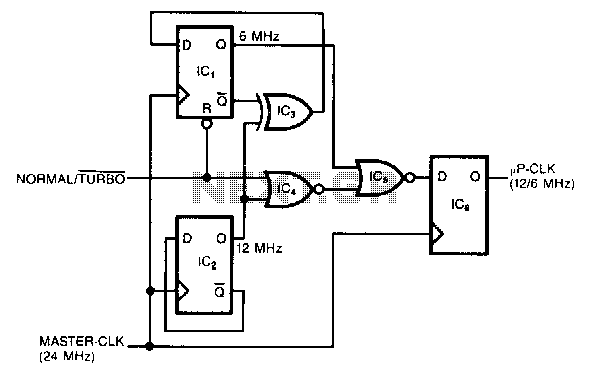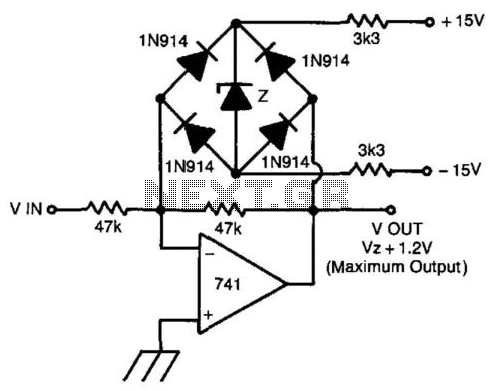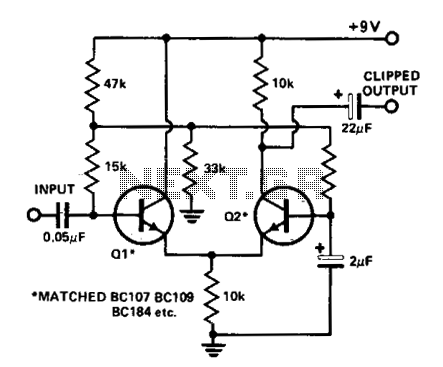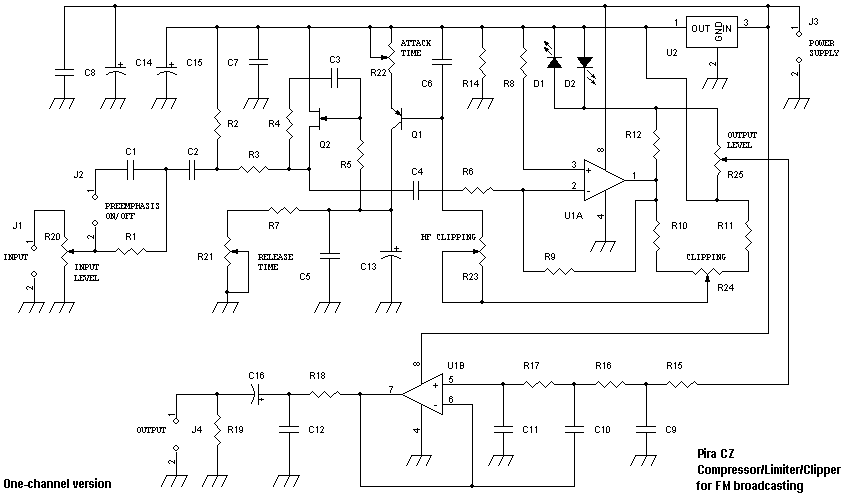
Glitch-Free Clipper
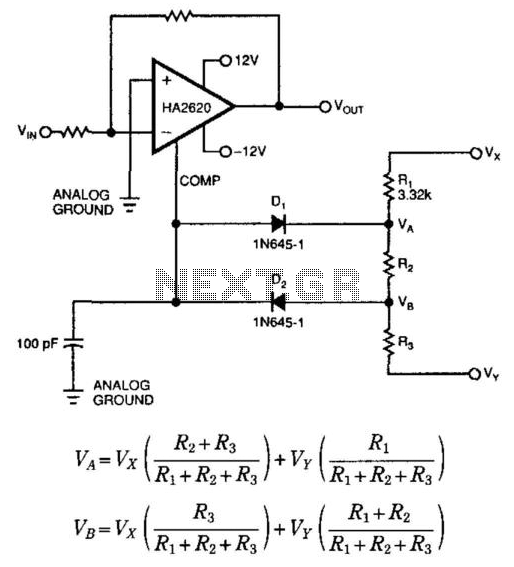
A simple clamping circuit can be added to a Harris 2620 high-speed operational amplifier (op-amp) to create a glitch-free amplifier and clipper. The pin that controls the device's bandwidth is a high-impedance, isolated input, which also tracks the output voltage of the device. Components D1, D2, R1, R2, and R3 are configured to clamp the output voltage of the amplifier when the input voltage exceeds the specified clamping voltage limits. The voltage drop across diode D1 or D2 is represented as VD, while Vx and Vy denote the bias voltages of the clamping circuit. The choice of resistor R1 influences the values of R2 and R3, with an initial recommendation of approximately 3 kΩ for R1. In one example of this circuit, clamping voltages of ±3.7 V were achieved, resulting in a total harmonic distortion (THD) of less than -75 dB for a sinusoidal input signal at 30 kHz. When the input signal exceeded the ±3.7 V clamping threshold, the clipper effectively clamped the output voltage symmetrically without introducing glitches in the waveform.
The described clamping circuit enhances the functionality of the Harris 2620 op-amp by preventing distortion and ensuring signal integrity during high-voltage excursions. The high-impedance input pin is critical for maintaining the op-amp's performance characteristics, allowing it to accurately track the output voltage while minimizing loading effects. The diodes D1 and D2 serve as the primary clamping elements, allowing the output voltage to remain within the specified limits, thereby protecting the downstream circuitry from overvoltage conditions.
The selection of resistors R1, R2, and R3 is essential for setting the appropriate clamping levels and ensuring the desired response time of the circuit. By adjusting R1, the values of R2 and R3 can be fine-tuned, impacting the dynamic range and response of the clamping action. The recommended value of R1 at around 3 kΩ is a starting point that can be optimized based on the specific application requirements.
The performance of the clamping circuit can be assessed by examining the total harmonic distortion (THD) across a range of frequencies. The reported THD of less than -75 dB demonstrates the circuit's effectiveness in preserving signal quality, even with a sinusoidal input at 30 kHz. This level of performance indicates that the circuit is well-suited for audio applications and other scenarios where signal fidelity is paramount.
In practical implementation, the clamping circuit should be carefully laid out to minimize parasitic capacitance and inductance, which could affect the response time and overall performance. Additionally, the choice of diodes D1 and D2 should consider their switching speed and forward voltage drop to ensure optimal clamping action.
Overall, the integration of this clamping circuit with the Harris 2620 op-amp provides a robust solution for applications requiring precise voltage control and protection against signal distortion, enabling reliable operation in demanding electronic environments. Adding a simple clamping circuit to a Harris 2620 high-speed op amp produces a glitch-free amplifier/ clipper. The op a mp pin that controls the device"s bandwidth is a high-impedance, isolated input. This pin also tracks the device"s output voltage. Therefore, Dl, D2, RI, R2, and R3 will clamp the amplifier"s output voltage only when the amplifier"s input voltage exceeds your clamping-voltage limits. VD is the diode drop of Dl or D2. where Vx and Vy are the clamping circuit"s bias voltages. Choosing R lets you determine the values of R2 and R3. Try a value for Ri around 3 kfi. One example of this circuit had clamping voltages of ± 3.7 V and exhibited THD below - 75 dB for a sinusoidal, 30-kHz input signal.
When the input signal increased beyond the ± 3.7-V clamping voltage, the clipper symmetrically clamped the output voltage with no glitches in the waveform. 🔗 External reference
The described clamping circuit enhances the functionality of the Harris 2620 op-amp by preventing distortion and ensuring signal integrity during high-voltage excursions. The high-impedance input pin is critical for maintaining the op-amp's performance characteristics, allowing it to accurately track the output voltage while minimizing loading effects. The diodes D1 and D2 serve as the primary clamping elements, allowing the output voltage to remain within the specified limits, thereby protecting the downstream circuitry from overvoltage conditions.
The selection of resistors R1, R2, and R3 is essential for setting the appropriate clamping levels and ensuring the desired response time of the circuit. By adjusting R1, the values of R2 and R3 can be fine-tuned, impacting the dynamic range and response of the clamping action. The recommended value of R1 at around 3 kΩ is a starting point that can be optimized based on the specific application requirements.
The performance of the clamping circuit can be assessed by examining the total harmonic distortion (THD) across a range of frequencies. The reported THD of less than -75 dB demonstrates the circuit's effectiveness in preserving signal quality, even with a sinusoidal input at 30 kHz. This level of performance indicates that the circuit is well-suited for audio applications and other scenarios where signal fidelity is paramount.
In practical implementation, the clamping circuit should be carefully laid out to minimize parasitic capacitance and inductance, which could affect the response time and overall performance. Additionally, the choice of diodes D1 and D2 should consider their switching speed and forward voltage drop to ensure optimal clamping action.
Overall, the integration of this clamping circuit with the Harris 2620 op-amp provides a robust solution for applications requiring precise voltage control and protection against signal distortion, enabling reliable operation in demanding electronic environments. Adding a simple clamping circuit to a Harris 2620 high-speed op amp produces a glitch-free amplifier/ clipper. The op a mp pin that controls the device"s bandwidth is a high-impedance, isolated input. This pin also tracks the device"s output voltage. Therefore, Dl, D2, RI, R2, and R3 will clamp the amplifier"s output voltage only when the amplifier"s input voltage exceeds your clamping-voltage limits. VD is the diode drop of Dl or D2. where Vx and Vy are the clamping circuit"s bias voltages. Choosing R lets you determine the values of R2 and R3. Try a value for Ri around 3 kfi. One example of this circuit had clamping voltages of ± 3.7 V and exhibited THD below - 75 dB for a sinusoidal, 30-kHz input signal.
When the input signal increased beyond the ± 3.7-V clamping voltage, the clipper symmetrically clamped the output voltage with no glitches in the waveform. 🔗 External reference
